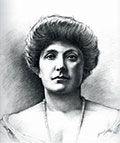Dame Nellie Melba (1861–1931)

World-renowned soprano.
Dame Nellie Melba's voice was remarkable for its even quality over a range of nearly three octaves, and for its pure, silvery timbre. She had international renown as a soprano, performing in many cities including Milan, Brussels, London, Paris and New York.
1861: Dame Nellie Melba was born Helen Porter Mitchell on 19 May 1861 at Richmond, Melbourne. Her Scottish father, David Mitchell, was a building contractor and a good bass vocalist, and her mother, Isabella (nee Dow), was her first music teacher.
1875–1880: She was educated at the Presbyterian Ladies' College, Melbourne, and received her early singing tuition from Ellen Christian and the Italian tenor Pietro Cecchi, who was credited with urging her to make singing her vocation.
1881: After the death of her mother in 1881, followed by that of her youngest sister, Melba accompanied her father to Mackay in Queensland, where he purchased a sugar mill.
1882: She married Charles Armstrong in Brisbane.
1883: Melba and Armstrong had a son, George.
1884: Returning to Melbourne, Melba decided to become a professional singer and gave a number of concerts and recitals.
1886: She had the opportunity to accompany her father to London. A successful audition with the celebrated Mathilde Marchesi in Paris gave her career the boost that it needed. She began lessons with Marchesi and was introduced to composers such as Delibes, Massenet and Gounod. It was Marchesi who persuaded her to adopt a suitable stage name. ‘Melba’ was chosen as a contraction of the name of her native city.
1887: Melba made her operatic debut in Brussels as Gilda in Verdi's Rigoletto and went on to sing with great success in London, Paris, Milan, New York and other major cities. Within a few years she was regarded as one of the most accomplished and famous sopranos of her time.
1889: After a successful debut in Paris, she subsequently established herself as Covent Garden's prima donna, and the ‘Queen of Song’ maintained her own permanent dressing-room there. One of her most famous operatic roles was that of Mimi in Puccini's La Bohème.
1900: Her marriage with Charles Armstrong ended in divorce.
1902: Melba's triumphant homecoming involved a concert tour of all Australian states and New Zealand.
1903: Melba returned to Europe in 1903 but came back to Australia many times.
1904–1926: During this time Melba made almost 200 recordings.
1909: She toured the Australian outback. In the same year, she bought a property at Coldstream near Lilydale, Victoria, and employed the architect John Grainger (father of the composer Percy Grainger) to design Coombe Cottage.
1911, 1924, 1928: During these years Melba brought the Melba-Williamson Opera Company to Australia.
1914–1918: Based in Australia during World War I, Melba worked tirelessly to raise funds for war charities. She also gave wartime concerts in North America. For her services to the war effort, Melba was made a Dame Commander of the Order of the British Empire in 1918. During this period she established a singing school at the Melbourne Conservatorium of Music in Albert Street, later renamed the Melba Memorial Conservatorium of Music, providing her services free of charge. She often travelled from Lilydale to teach her ‘Melba's Girls'.
1920: She became the first artist of international standing to participate in direct radio broadcasts.
1926: Melba gave a number of supposedly ‘final’ performances. Her final Covent Garden performance was in 1926.
1927: She sang at the opening of Parliament House in Canberra, and was made a Dame Grand Cross of the Order of the British Empire.
1928: Her final and emotional concerts took place in in Australia.
1931: Melba died in Sydney on 23 February 1931 and was buried at the Lilydale Cemetery in Victoria.
2008: The private conservatorium, Melba Memorial Conservatorium of Music, ceased teaching and became the Dame Nellie Melba Opera Trust.
Further information is available in Notable Australians.